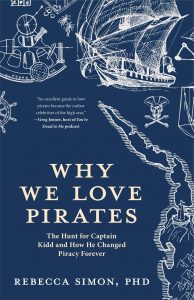I was lucky enough to teach the history of Atlantic piracy at my independent school. In fact, that’s actually why I was hired. The department chair thought the subject would be a great thing to bring to the middle school humanities curriculum.
At first I wondered how I’d fit it in and make it a “serious” subject rather than simply a “yay easy fun times!” unit. But it turned out to be really easy. I taught 7th grade at my school and our subject was Global Studies. My co-teacher and I rebuilt the curriculum to make the essential question about revolution and bottom-up social changes. Early modern Atlantic piracy was our choice to finish out the year because it would be a natural bridge to 8th grade, which is American studies.
So what did we do? We took the social route and used pirates as an example of how and why people might reject their societies and create their own (as they did on their ships). Our unit text was a great book called Pirates! by Celia Rees, which is about two young women – the daughter of a plantation owner named Nancy and an enslaved girl named Minerva – who are on the run after killing an overseer who assaulted Minerva. They are welcomed onto a pirate ship and create new lives.

The history portion of the unit was all about research, especially primary research. Students engaged with early modern maps of the Atlantic world and primary sources from the time period. I introduced short snippets of newspapers, last dying speeches, and pieces from A General History of the Pyrates.
I can’t speak for everyone, but for me it was hard enough to get used to the 18th century style of writing and spelling. Imagine how it would be for 13-year-olds!
Good People! The Multitude and Noise is so great; that I am afraid I shall be heard but by a few of you…I freely Confess I have abundantly and beyond measure or expression offend the Laws of my God, and in Too many Cases the Laws of my Country: ‘Tis well known to many, I suppose some present, that I served His Majesty Faithfully in the Late and Former Dutch Wars, and I am heartily sorry for my Crimes…
The Last Dying Speech of George Cusack, 1675
We broke things down line by line and focused on details such as the year it was written, the subject, and what places were mentioned. After a little bit of time they were able to transcribe the sources and deepen their understanding of how pirates lived and how they were perceived.
Media proved to be a really valuable tool. One of the first things we did was watch the opening scene from Master and Commander so we could have a discussion about how sailors on a ship cooperated when faced with a sudden attack. Then we watched a scene from the film Captain Phillips when the Somali pirates boarded the Maersk Alabama. It made for a great compare/contrast.
The final project was an opportunity for students to get into the perspective of piracy. They had a creative writing project in which they could write a newspaper article, a last-dying speech, a fictional pirate biography, and a short story. The purpose of this project was to deepen their research skills so we provided them with some sources and then students were instructed to find more of their own. Their writing had to be as historically accurate as possible.
They all rose to the occasion with gusto and it ended up being our most successful project. Pirates hold so much public interest but piracy is an excellent subject to pursue the revolutionary idea of new societies.
And, of course, we finished the year by watching Pirates of the Caribbean: The Curse of the Black Pearl, because how could we not?


